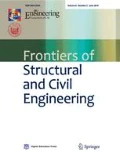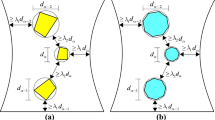Abstract
We present a three-dimensional (3D) numerical model to investigate complex fracture behavior using cohesive elements. An efficient packing algorithm is employed to create the mesoscale model of heterogeneous capsule-based self-healing concrete. Spherical aggregates are used and directly generated from specified size distributions with different volume fractions. Spherical capsules are also used and created based on a particular diameter, and wall thickness. Bilinear traction-separation laws of cohesive elements along the boundaries of the mortar matrix, aggregates, capsules, and their interfaces are pre-inserted to simulate crack initiation and propagation. These pre-inserted cohesive elements are also applied into the initial meshes of solid elements to account for fracture in the mortar matrix. Different realizations are carried out and statistically analyzed. The proposed model provides an effective tool for predicting the complex fracture response of capsule-based self-healing concrete at the meso-scale.
Similar content being viewed by others
References
Cailleux E, Pollet V. Investigations on the development of self-healing properties in protective coatings for concrete and repair mortars. In: Proceedings of the 2nd International Conference on Self-Healing Materials. Chicago, IL, 2009
Dry C. Matrix cracking repair and filling using active and passive modes for smart timed release of chemicals from fibers into cement matrices. Smart Materials and Structures, 1994, 3(2): 118–123
White S, Maiti S, Jones A, Brown E, Sottos N, Geubelle P. Fatigue of self-healing polymers: Multiscale analysis and experiments. In: 11th International Conference on Fracture. Turin, 2005
de Borst R. Some recent developments in computational modelling of concrete fracture. International Journal of Fracture, 1997, 86(1): 5–36
Murthy A R C, Palani G, Iyer N R. State-of-the-art review on fracture analysis of concrete structural components. Sadhana, 2009, 34(2): 345–367
Wu M, Johannesson B, Geiker M. A review: Self-healing in cementitious materials and engineered cementitious composite as a self-healing material. Construction & Building Materials, 2012, 28(1): 571–583
Van Tittelboom K, deBelie N. Self-healing in cementitious materialsa review. Materials (Basel), 2013, 6(6): 2182–2217
Talaiekhozan A, Abd Majid M Z. A review of self-healing concrete research development. Journal of Environmental Treatment Techniques, 2014, 2(1): 1–11
Mauludin L M, Oucif C. Modeling of self-healing concrete: A review. Journal of Applied and Computational Mechanics, 2019, 5: 526–539
Oucif C, Mauludin L. Continuum damage-healing and super healing mechanics in brittle materials: A state-of-the-art review. Applied Sciences (Basel, Switzerland), 2018, 8(12): 2350
Mauludin L M, Budiman B A, Santosa S P, Zhuang X, Rabczuk T. Numerical modeling of microcrack behavior in encapsulation-based self-healing concrete under uniaxial tension. Journal of Mechanical Science and Technology, 2020, 34(5): 1847–1853
White S R, Sottos N, Geubelle P, Moore J, Kessler M, Sriram S, Brown E, Viswanathan S. Autonomic healing of polymer composites. Nature, 2001, 409(6822): 794–797
Zemskov S V, Jonkers H M, Vermolen F J. Two analytical models for the probability characteristics of a crack hitting encapsulated particles: Application to self-healing materials. Computational Materials Science, 2011, 50(12): 3323–3333
Mookhoek S D, Fischer H R, van der Zwaag S. A numerical study into the effects of elongated capsules on the healing efficiency of liquid-based systems. Computational Materials Science, 2009, 47(2): 506–511
Lv Z, Chen H. Analytical models for determining the dosage of capsules embedded in self-healing materials. Computational Materials Science, 2013, 68: 81–89
Gilabert F, Garoz D, Van Paepegem W. Stress concentrations and bonding strength in encapsulation-based self-healing materials. Materials & Design, 2015, 67: 28–41
Lv Z, Chen H, Yuan H. Analytical solution on dosage of self-healing agents in cementitious materials: long capsule 229 model. Journal of Intelligent Material Systems and Structures, 2014, 25(1): 47–57
Kaltzakorta E, Erkizia I. Silica microcapsules encapsulating epoxy compounds for self-healing cementitiousmaterials. In: Proceedings of 3rd International Conference on Self Healing Materials. Bath, 2011
Hilloulin B, Van Tittelboom K, Gruyaert E, de Belie N, Loukili A. Design of polymeric capsules for self-healing concrete. Cement and Concrete Composites, 2015, 55: 298–307
Alexeev A, Verberg R, Balazs A C. Patterned surfaces segregate compliant microcapsules. Langmuir, 2007, 23(3): 983–987
Mauludin L M, Oucif C. The effects of interfacial strength on fractured microcapsule. Frontiers of Structural and Civil Engineering, 2019, 13(2): 353–363
Mauludin L M, Oucif C. Interaction between matrix crack and circular capsule under uniaxial tension in encapsulation based self-healing concrete. Underground Space, 2018, 3(3): 181–189
Mauludin L M, Zhuang X, Rabczuk T. Computational modeling of fracture in encapsulation-based self-healing concrete using cohesive elements. Composite Structures, 2018, 196: 63–75
Wriggers P, Moftah S. Mesoscale models for concrete: Homogenisation and damage behaviour. Finite Elements in Analysis and Design, 2006, 42(7): 623–636
Hirsch T J. Modulus of elasticity of concrete affected by elastic moduli of cement paste matrix and aggregate. Journal Proceedings, 1962, 59: 427–452
Daudeville M L. Role of coarse aggregates in the triaxial behavior of concrete: experimental and numerical analysis. Dissertation for the Doctoral Degree. Cergy-Pontoise: Cergy-Pontoise University, 2014
Du X, Jin L, Ma G. Numerical modeling tensile failure behavior of concrete at mesoscale using extended finite element method. International Journal of Damage Mechanics, 2014, 23(7): 872–898
Gruyaert E, Van Tittelboom K, Sucaet J, Anrijs J, Van Vlierberghe S, Dubruel P, de Geest B, Remon J P, de Belie N. Capsules with evolving brittleness to resist the preparation of self-healing concrete. Construction Materials, 2016, 66 (323): e092
Quayum M S, Zhuang X, Rabczuk T. Computational model generation and rve design of self-healing concrete. Frontiers of Structural and Civil Engineering, 2015, 9(4): 383–396
Simulia, Abaqus 6.13 Documentation, 2013
Yang Y, Ning Y, Wang C, Tong Z. Capsule clusters fabricated by polymerization based on capsule-in-water-in-oil pickering emulsions. Polymer Chemistry, 2013, 4(21): 5407–5415
Wang X, Jivkov A P. Combined numerical-statistical analyses of damage and failure of 2d and 3d mesoscale hetero geneous concrete. Mathematical Problems in Engineering, 2015: 1–12
Wang X, Xing F, Zhang M, Han N, Qian Z. Experimental study on cementitious composites embedded with organic microcapsules. Materials (Basel), 2013, 6(9): 4064–4081
Keller M, Sottos N. Mechanical properties of microcapsules used in a self-healing polymer. Experimental Mechanics. 2006, 46(6): 725–733
You Y J, Kim J H J, Park K T, Seo D W, Lee T H. Modification of rule of mixtures for tensile strength estimation of circular GFRP rebars. Polymers, 2017, 9(12): 682
Wang J, Soens H, Verstraete W, de Belie N. Self-healing concrete by use of microencapsulated bacterial spores. Cement and Concrete Research, 2014, 56: 139–152
Kanellopoulos A, Giannaros P, Al-Tabbaa A. The effect of varying volume fraction of microcapsules on fresh, mechanical and self-healing properties of mortars. Construction & Building Materials, 2016, 122: 577–593
Lv L, Schlangen E, Yang Z, Xing F. Micromechanical properties of a new polymeric microcapsule for self-healing cementitious materials. Materials (Basel), 2016, 9(12): 1025
Acknowledgements
The authors thank the support of the RISTEK-DIKTI (Directorate General of Resources for Science, Technology and Higher Education. Ministry of Research, Technology and Higher Education of Indonesia) under funding agreement No: 153.39/E4.4/2014 as well as the project ‘Carl-Zeiss Stiftung’ Durchbrüche—Exzellenz in der Forschung: ‘Funktionalisierung 191 smarter Werkstoffe unter Mehrfeldanforderungen fur die Verkehrsinfrastruktur’.
Author information
Authors and Affiliations
Corresponding author
Rights and permissions
About this article
Cite this article
Mauludin, L.M., Rabczuk, T. Computational modeling of fracture in capsule-based self-healing concrete: A 3D study. Front. Struct. Civ. Eng. 15, 1337–1346 (2021). https://doi.org/10.1007/s11709-021-0781-1
Received:
Accepted:
Published:
Issue Date:
DOI: https://doi.org/10.1007/s11709-021-0781-1



